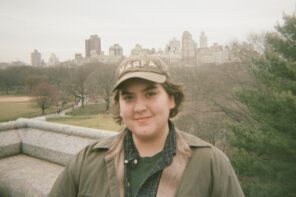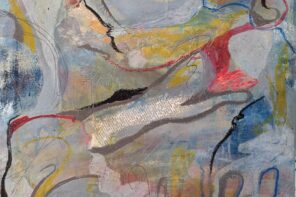I’d taken a personal day to visit the hospital where my friend was dying of cancer. The visit was short; she was fatigued, and my vocabulary felt limited. When the sliding glass doors whisked shut behind me, I took a great gulp of air and felt passionately about my own health. At that moment, more than anything, what I wanted was to be obliterated, to be left alone to sit in the dark in a movie theater and get pummeled with surround-sound images with no room left for reflection.
I remembered thinking that I will think back on this time as the years everyone was dying of cancer. I remembered thinking I could make such assessments from my perch in the future because there I would be, the future me. Other people’s people were dying of COVID, but my crowd—friends mostly in their fifties and sixties, uniformly unessential and fastidious about the science—had managed to mostly evade the worst of the global pandemic, only to succumb to an ordinary killer.
At the hospital, my friend, who had rallied and flopped, surged and sweated, had decided she’d had enough with treatments. She lay garlanded by expensive bouquets and a slim stack of books written by poets who had converted to Buddhism.
In the spirit of things, I asked her: Is there any wisdom you want to pass onto me?
My friend replied: Why would I start now? And then she turned away as though her joke had taken all the energy she had left for the day, the rest of her life.
That evening I should have gone to the movies but instead I went to see an art film because the art film I was curious about was screening for one night only. It was playing as part of an avant-garde film festival that existed solely online in its inaugural year. Now in its second year, the festival was testing its viability in a physical cinema among bodies trussed in outerwear.
I’d read a brief write-up of the film in the festival program which described it as being composed of conceptual found footage drawn from hundreds of films from around the world, and featuring an ensemble cast of actors with one thing in common: each is no longer alive.
I had searched, as I always do, for a trailer to the film but much to my surprise, no such trailer existed, which had the effect of making me want to see the film even more. In my head I imagined an entire film populated entirely by ghosts and zombies and specters and spooks, a cunning assemblage of ectoplasmic hijinks from the silent era to more contemporary apparitions lunging from the screens of television sets. I thought perhaps what I wanted wasn’t oblivion after all, but immersion: to stick my nose deeper into that carton of rotted milk and breathe deeply, to flap my arms and roll around in death.
From the Upper East Side, I boarded the subway and emerged at 36th Avenue. I walked the length of a broad boulevard past a dollar store, a few wireless money transfer spots, a shuttered Lucille Roberts gym and a celebrated empanada restaurant. Despite the lateness in the day, the air was still hot and there were few people in the street. The theater, which was inside a museum devoted to the moving image, was about a third full when I arrived. I took a seat respectfully away from others and scrolled through my phone looking at trifles until the lights dimmed.
The film began with scenes of people walking. They walked with resolute strides across a deserted street at night, the pavement slick from an earlier rain. They strolled down movie-set Main Streets and alongside a riverbank. They slogged through a wintry field, sinking knee-deep into the snow. They perambulated, lost in thought, following a set of train tracks. They walked with their hands stuffed in their coat pockets, with their heads down, with their chins lifted, peering around the corner, their Foley footsteps clopping and clacking.
But where was everyone walking to? At last, the destination appeared, signaled by a neon sign hung above an alleyway: The Afterlight.
The bartender poured a drink. A customer sidled up to the counter. A couple hunched over a tiny cocktail table. A man, his hair swirled in pomade, surveyed the room over his shoulder idly, cloaking his hope. Another bartender wiped shot glasses with a cloth (did this only happen in movies?) and poured out another drink.
I slouched in my seat. My understanding of the film’s premise had been misguided, and in the thick of my disappointment, I had to laugh at myself a little. It wasn’t the undead populating the screen but actors who had died in real life off-screen. Even so, there was something otherworldly about the film and its setting. Removed from the context of plot, motivation, and purpose, stripped of soundtrack and dialogue, the figures on-screen seemed to exist outside even the movies themselves, their natural habitat.
After a long time spent in the confines of the bar, the scene shifted to the outdoors again. But despite a glorious sequence of cumulus clouds roiling in the sky shot through with sunlight, the overall mood remained peripatetic. The people in the film returned to the task of walking, of pacing the cobblestones, making their way down a dirt road, slipping into alleyways. They walked and kept walking until they made their way once again to their desultory elixirs and sour occupations that awaited them past the glowing entrance of The Afterlight.
When the film ended, I stayed for the Q&A with the filmmaker. He was thin, young, wryly British, with a mop of blond locks. Someone in the audience asked him if he felt it was ghoulish at all to be waiting on someone to expire so a clip could be included in his film.
The filmmaker replied that most of the actors were already dead by the time he was making the film, but it was true, there were a handful who appeared in the clips he wanted to use who had not yet died; then when they finally did die, he was able to include the footage, which gave him a satisfied feeling which he compared to the closing of a circle. His words made me shudder inwardly. In my mind I imagined a lepidopterist pinching the thorax of a prized blue Morpho and pinning the carcass to a framed mount.
There’s only one print of the film in existence, the filmmaker went on to say, a single 35mm print. This means every time the film screens, it erodes little by little. I’ve already begun to detect small blemishes, the filmmaker said. The more it is screened, the more people see it, the more it will disintegrate until one day it will become virtually unwatchable.
At the hospital I pulled up a chair and sat very close to my friend. Together we were still. I was able to really look at her without the usual distractions of a restaurant or traffic or any number of things that clattered in the background of a lifetime of chance and planned encounters between us. I stared at the nick the shape of a cutlass moon high on her forehead and recalled the origin story of the injury, a gash following a blackout—she’d drunk too much vodka at a going-away party for a theater director we both knew who’d once groped her. She had eeled away from his grasp, laughed, and flipped him off; it’s what you did in those days. She told me she woke up in bed the morning after with her left eye gummed shut from the blood that had dripped down and clotted her eyelashes. I wanted to avenge her but didn’t know how. Instead, I parted my hair to show her the scar across my eyebrow from a drunk driving incident involving an old boyfriend.
My friend got sober soon after that. And I know you aren’t supposed to say this, but she wasn’t nearly as fun. I don’t think she’d disagree. The world, as a sober person, she once told me, was much more clear but also less bright. Of course, by then she wasn’t the only one who’d quit drinking and using and dancing and making art no one wanted. Our lives had shifted to a different register, one organized by children and elderly parents, personal and impersonal days.
When the questions from the audience members fell away, the event ended with a blast of applause. I shuffled out of the theater and into the lobby of the museum where clusters of people were chattering. I recognized no one and was in a hurry to be rid of myself. Night had fallen and the full moon was visible only as a pale smear behind a bank of clouds. I rushed out into the street, retracing my steps back to the subway station, not bothering, as I ordinarily would, to walk on the opposite side of the street from the route I’d taken earlier for the sake of variety.
Dust collects on film. Moisture and fingerprints and microplastics and particulate matter and toxic residue accumulate and churn and embed themselves in our organs until cancer is cooked. Then what? Our souls wander through their new eternity among strangers, absent the people we know: our context. We circle the grounds and pick up smoking again, sigh too loudly, throw ourselves off mountains for sport, beyond the possibility of ruin.
I think this is it, then, said my friend when I squeezed her hand on my way out the door. She pressed her lips together, approximating a smile. I couldn’t bring myself to kiss her cheek because it was nothing I’d ever done when she was well. The only time people think to describe you as well is when you’ve been somehow unwell. She must have thought that would be my last visit, but I would return one more time. They encouraged me to talk to her. They said: It’s quite possible that she can still hear you. I got close to her face even though the paleness of her skin scared me and said, Remember how we used to not know how the night would end? There was movement beneath her eyelids. Yes, no?
Lisa Hsiao Chen is the author of Activities of Daily Living (W.W. Norton, 2022). She was born in Taipei and now lives in Brooklyn.




